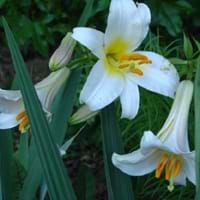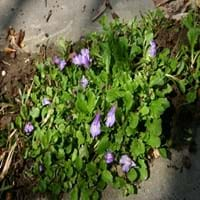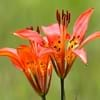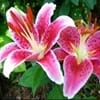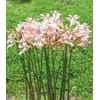Life Span
Perennial
Perennial
Type
Bulb or Corm or Tuber
Perennial
Origin
Hybrid origin, North America, Europe, Africa, Asia
Southeastern Asia, Nepal
Types
White lily, orange lily, Lily of the valley
Not Available
Habitat
Not Available
Coastal Regions, Cold Regions, Terrestrial
USDA Hardiness Zone
2-8
5-8
Sunset Zone
21,22
1a, 1b, 2a, 2b, 3a, 3b, 4, 5, 6, 7, 8, 9, 14, 15, 16, 17, 18, 19, 20, 21, 22, 23, 24
Habit
Upright/Erect
Mat-forming
Flower Color
White, Yellow, Red, Green, Purple, Gold, Pink, Rose, Peach, Burgundy, Bronze
White, Blue Violet
Flower Color Modifier
Bicolor
Bicolor
Fruit Color
Yellow green, Sandy Brown
Not Available
Leaf Color in Spring
Green, Dark Green
Green
Leaf Color in Summer
Light Green
Green
Leaf Color in Fall
Several shades of Green
Green
Leaf Color in Winter
Light Green
Light Green
Leaf Shape
Long Linear
Lance shaped
Plant Season
Spring, Summer, Fall
Spring, Summer, Fall, Winter
Sunlight
Full Sun, Partial Sun, Partial shade
Full Sun, Partial Sun, Partial shade
Type of Soil
Clay, Loam, Sand
Loam, Sand
The pH of Soil
Acidic, Neutral, Alkaline
Neutral
Soil Drainage
Well drained
Well drained
Bloom Time
Not Available
Late Spring, Early Summer, Summer
Tolerances
Drought
Drought
Where to Plant?
Container, Ground, Pot
Ground
How to Plant?
From bulbs, Seedlings, Seperation
Seedlings
Plant Maintenance
Medium
Low
Watering Requirements
Do Not over Water
Average Water Needs, Do Not over Water, Never Over-water, Requires regular watering
In Summer
Lots of watering
Lots of watering
In Spring
Moderate
Moderate
In Winter
Average Water
Average Water
Soil pH
Acidic, Neutral, Alkaline
Neutral
Soil Type
Clay, Loam, Sand
Loam, Sand
Soil Drainage Capacity
Well drained
Well drained
Sun Exposure
Full Sun, Partial Sun, Partial shade
Full Sun, Partial Sun, Partial shade
Pruning
Prune in early spring, Prune in fall, Remove dead or diseased plant parts
Prune if you want to improve plant shape, Remove damaged leaves, Remove dead leaves
Fertilizers
Compost, Fertilize only when soil is poor, Organic Flower Fertilizer
fertilize in growing season, Less fertilizing
Pests and Diseases
Aphids, Lily Beetle, Stem canker
Insects
Plant Tolerance
Drought
Cold climate
Flower Petal Number
Single
Single
Foliage Texture
Not Available
Fine
Foliage Sheen
Not Available
Matte
Attracts
Birds, Hummingbirds, Not Available, Snails
Butterflies, Insects
Allergy
Mild Allergen, Not Available, sneezing
Asthma
Aesthetic Uses
Beautification, Showy Purposes
Beautification, Ground Cover, Landscape Designing, Showy Purposes, Used for decorating walls, fences, gates, hedges, etc.
Beauty Benefits
Making cosmetics
Not Available
Environmental Uses
Fixes Nitrogen, Indoor Air Purification
Air purification, Food for insects, No fertilizer, pesticides, or herbicides needed, Prevent Soil Erosion
Medicinal Uses
Burns, Diuretic, Heart problems
Cough
Part of Plant Used
Whole plant
Whole plant
Other Uses
Application in Handicrafts, Basketary, Cosmetics, Oil is used for aromatherapy, Oil is used in mosquito repellents, Used as Ornamental plant, Used for its medicinal properties
Decoration Purposes, Employed in herbal medicine, Showy Purposes
Used As Indoor Plant
Yes
No
Used As Outdoor Plant
Yes
Yes
Garden Design
Alpine, Container, Cutflower, Feature Plant, Mixed Border, Wildflower
Alpine, Edging, Groundcover, Rock Garden, Wall
Botanical Name
LILIUM
MAZUS reptans
Common Name
Lily
Creeping Mazus
In German
Lilie
Creeping Mazus
In French
Lis
Creeping Mazus
In Spanish
Lirio
arrastramiento Mazus
In Greek
Κρίνος
υφέρπουσα Mazus
In Portuguese
Lírio
Creeping Mazus
In Polish
Lilia
Creeping Mazus
In Latin
lilium
reptilia Alba
Phylum
Tracheobionta
Anthophyta
Class
Liliopsida
Dicotyledonae
Order
Liliales
Scrophulariales
Family
Liliaceae
Scrophulariaceae
Clade
Angiosperms, Monocots
Angiosperms, Asterids, Eudicots
Subfamily
Lilioideae
Mimuloideae
Number of Species
Not Available
Season and Care of Trumpet Lily and Creeping Mazus
Season and care of Trumpet Lily and Creeping Mazus is important to know. While considering everything about Trumpet Lily and Creeping Mazus Care, growing season is an essential factor. Trumpet Lily season is Spring, Summer and Fall and Creeping Mazus season is Spring, Summer and Fall. The type of soil for Trumpet Lily is Clay, Loam, Sand and for Creeping Mazus is Loam, Sand while the PH of soil for Trumpet Lily is Acidic, Neutral, Alkaline and for Creeping Mazus is Neutral.
Trumpet Lily and Creeping Mazus Physical Information
Trumpet Lily and Creeping Mazus physical information is very important for comparison. Trumpet Lily height is 30.00 cm and width 30.00 cm whereas Creeping Mazus height is 250.00 cm and width 30.50 cm. The color specification of Trumpet Lily and Creeping Mazus are as follows:
Trumpet Lily flower color: White, Yellow, Red, Green, Purple, Gold, Pink, Rose, Peach, Burgundy and Bronze
Trumpet Lily leaf color: Green and Dark Green
Creeping Mazus flower color: White and Blue Violet
- Creeping Mazus leaf color: Green
Care of Trumpet Lily and Creeping Mazus
Care of Trumpet Lily and Creeping Mazus include pruning, fertilizers, watering etc. Trumpet Lily pruning is done Prune in early spring, Prune in fall and Remove dead or diseased plant parts and Creeping Mazus pruning is done Prune if you want to improve plant shape, Remove damaged leaves and Remove dead leaves. In summer Trumpet Lily needs Lots of watering and in winter, it needs Average Water. Whereas, in summer Creeping Mazus needs Lots of watering and in winter, it needs Average Water.
